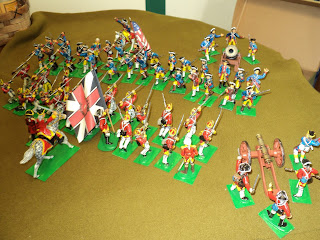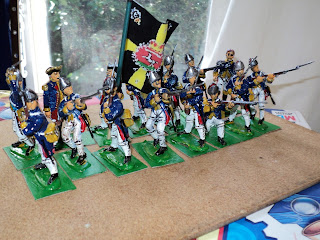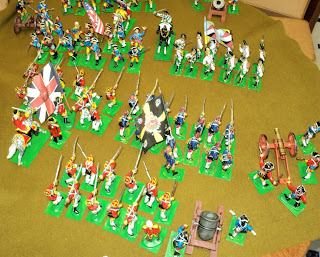 |
The battlefield, looking east along to autobahn towards Kustrin.
Just off the table to the left is the river Oder. |
I've been thinking a lot lately about my WW2 inventories, and what to do with them all. Although I have a fondness for
Command Decision, especially in its second incarnation, there are too few accessible like-minded gamers in this town. The other drawback is that you really want a biggish table to play the game.
 |
A small town that is the immediate objective of the German
right hand column. |
This set-up has been cluttering up my back room for over a month now - I've visited my daughter and son-in-law in Brisbane, Australia, since laying out this table. This is not good. I haven't begun to play the game on it. The intention was by way of an experiment: re-scaling the ground from 1:1800 (1 inch to 50 yards) to 1cm to 50 yards, a scale of 1:4500. Seems an unlikely conversion, but may be worth a try. But I also need to find my rule sets and ORBATS, and to download and print the CD3 stat sheets before beginning the action.
 |
The main German objective: this large town. Possibly it
is Kustrin. |
The scenario laid out here is based by a dim memory of something from the computer game
Steel Panthers: World At War. Set very late in the War, March 1945 - in fact there ought to be patches of snow here and there about - this is a German counter-attack to recapture the sizeable town and railway station in the northeastern corner of the board. The defenders comprise a Soviet Rifle Brigade, hastily dug in and reinforced with small groups of T34/76 tanks. However,apart from the organic field artillery and mortar battalions they are supported by powerful heavy artillery and rocket batteries off table, with pre-programmed fire missions.
 |
| The Soviet rear areas, just west of Kustrin. |
The Germans are to make a three-pronged attack with armour and infantry - panzer-grenadiers - with some artillery support, mostly again off table. On both flanks, the armour comprises a mixed company of Tiger II and Panthers; in the centre
Jagdpanther and
Jagdpanzer IV with a
StuGIV to arrive from off-table. The whole rather polyglot battlegroup is supported by Quad 20mm AA, towed anti-tank guns and assorted oddments. The centre column is led by armoured reconnaissance.
 |
Looking along the line of the stream and the Soviet
defences. The rather orphaned infantry gun wants a base
and a crew. |
The pictures you see here depict the battlefield, with the Russian Rifle Brigade in situ, awaiting the worst. The Germans are just crossing their start lines.
 |
Russian infantry, armour and anti-tank
covering the autobahn. |
But I am seriously looking in future to going the
Not Quite Mechanised or possibly the
Megablitz route. Back in January I picked up some second-hand equipment - mostly German - and, after a rethink, grabbed a job lot of plastic Russian infantry. I don't know the makers (observant readers might be able to tell me) but they are very nice figures. Whoever had them before me picked out a few bits and pieces, and I got the rest.
 |
| Add caption |
From them I was able to assemble 5 groups of 6 stands each comprising 3 'rifle' bases (one with LMG), 1 MMG base, 1 Mortar base and 1 Antitank Rifle (PTRS) base. It seemed to me these groups would make fine battalions in the Not Quite Mechanised (NQM) style. The complete sprues would have given me a sixth such group, but the absent support weapons can be supplies easily enough from my existing inventory. You will observe that I haven't been over-consistent with the base sizes. At that they will not fit on the 'standard' NQM 'stands' as I infer them. I'll probably go for stands 10cm wide by 5cm deep (ground 'footprint' 250m x 125m. The temptation is to make them 12cm by 6cm, to match the 'real estate' of a battalion in defence, as per spec. There remained some command and comms figures, and more SMG armed fellows that seemed to suggest SMG-armed fighting bases for Rifle Brigade SMG platoons/companies, or tank 'desantski'.
 |
Grouped plastic infantry - see text. The flagged command
stand is metal, the flag home made from paper. The flag
was machine generated - I had to design the hammer and sickle
motif pixel by pixel. |
Chris Kemp's own NQM ORBAT for Soviet Rifle divisions call for slightly smaller battalion groups, with 3 'fighting' rifle bases and 2 'support' bases, one of which is a command base. I think that my own battalion group 'fits' a rifle or mechanised brigade's battalions as well. I am very tempted to add a seventh 'base' as a separate 'command' ('C' with 1 strength point or possibly 0 SP) or maybe 'command/SMG platoon' (CF1).
 |
A NQM Rifle Battalion? Figures undercoated black
and dry-brushed white over the top. Up coming painting
project.
|
My tentative Orbat for a Rifle or mechanised Brigade looks something like this:
Brigade Command*:
Commander, car/jeep or GAZ,
Signals stand with appropriate comms vehicle
3 Rifle Battalions each with:
1 command + support bases: 1 50mm or 82mm Mortar + 1 MMG + 1 PTRS/PTRD (SP=3)
3 fighting bases (armed with rifles, SMG and LMG) (SP=3).
Total battalion SP=6
1 Artillery Battalion:
0-1 FO; 1x76.2 field artillery (SP=2, or SP=3 for Guards Brigade)
1 Mortar battalion:
0-1 FO: 1x120mm or 82mm mortar (SP=2, or SP=3 for Guards)
1 Organic Anti-tank Guns
1x37mm, 45L46, 45L66 or 57mm AT (SP=2, or SP=3 for Guards)
1 'Motorcycle/Recon' Battalion**
1x recon Motorcycle (SP=2), 1x recon jeep with (opt) AAMG (SP=2), 1x armoured car (SP=2)
1 Tank Regiment (Mechanised Brigade only)***
1xT34 or Sherman tank (SP=3); 1x command T34 or Sherman (SP=2)
* As I have more in the way of command and comms figures than vehicles for them, I'm as likely to filed them as personnel stands rather than vehicle stands, or, probably, both.
** The Motorcycle unit seems to have been a mixed bag, so much so that one can't really speak in terms of a 'typical' such unit. Some even had tanks. However, my own seems to be a reasonable example. I suggest that one might whack in whatever takes your fancy up to a maximum SP of 6. So the
76th M/C Battalion of 4th Guards Tank Corps might be depicted like this: 1 x m/c (SP=1), 1 x BA32 (SP=1), 1 x M3 halftrack (SP=1), 1 x light tank (SP=1), 1 x Anti-tank Gun (SP=1), 1 x Field gun (SP=1). A rather special unit!
***In NQM terms the first tank would count as 'F3' the second as 'CS2', for the rest, I have left off the fighting, support and command designations for the time being. I have not yet determined what the logistics (LOG) elements should be.
 |
And NQM battalion in road column, marching past a
potential LOG element. |
But in the picture above, I have offered some indication that infantry units might well include a pack horse stand with, say two horses, or a wagon or cart drawn by a single horse.
All of this is so far quite tentative, and something to think about in the cold winter months...




























